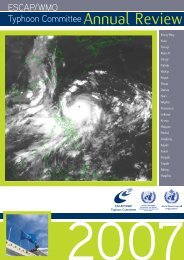TCAR - Typhoon Committee
TCAR - Typhoon Committee
TCAR - Typhoon Committee
Create successful ePaper yourself
Turn your PDF publications into a flip-book with our unique Google optimized e-Paper software.
Fig. 39. Impact of IASI data in tropical areas in<br />
KMA UMS 4DVAR (KO_CYCLG: Without IASI;<br />
KO_CYCLG (w/ IASI): With IASI).<br />
In 2010, GPSRO and SSMIS will be assimilated in<br />
4DVAR for global application of the UM.<br />
Direct readout satellite data such as ATOVS<br />
and AIRS will be assimilated in the regional<br />
application of the UM with the least latency time.<br />
High temporal and spatial resolution AMV data<br />
retrieved from COMS (Communication, Ocean,<br />
and Meteorological Satellite), scheduled for<br />
launch in early 2010, will be evaluated with<br />
4DVAR in the UM to produce better typhoon<br />
location and intensity forecasts.<br />
Adoption of the Unified Model as KMA’s Nextgeneration<br />
NWP System<br />
KMA decided to adopt the Unified Model (UM) of<br />
the UK Met Office, and has been developing a<br />
new next-generation NWP system based on the<br />
UM since 2008. A preliminary global UM suite<br />
using initial conditions from the UK Met Office<br />
started operations in June 2008. Results are<br />
provided to forecasters, who use them as auxiliary<br />
material to help produce weather products such<br />
as accurate and timely typhoon forecasts.<br />
Recently, a global 4DVAR data assimilation<br />
system was added to the global UM suite along<br />
with observation pre-processing procedures for<br />
various observations to produce more accurate<br />
and consistent numerical weather predictions.<br />
KMA conducted a UM re-run project for the past 3<br />
years (2006-2008). Although the main objective<br />
of the project was to produce UM-based forecast<br />
guidance using MOS (Model Output Statistics),<br />
the results are expected to prove useful for<br />
various purposes such as model performance<br />
assessment in the East Asian region, etc. In a<br />
preliminary analysis, forecast fields were verified<br />
relative to tropical cyclone (typhoon) tracks<br />
issued in the Northwest Pacific region.<br />
The UM system shows improved typhoon track<br />
forecast skill compared to the operational global<br />
(GDAPS) prediction. The 3-day (5-day) typhoon<br />
position prediction error of the UM is 360<br />
km (420 km) on average (50% of cumulative<br />
frequency), which is far smaller than errors of<br />
GDAPS (490 km and 510 km for 3- and 5-day<br />
forecasts, respectively). In fact, the 5-day<br />
<strong>TCAR</strong><br />
CHAPTER 1 - TYPHOON COMMITTEE ACTIVITIES<br />
lti<br />
typhoon position prediction of the UM is better<br />
than the 3-day prediction of GDAPS. The global<br />
UM-4DVAR suite is slated to become KMA’s nextgeneration<br />
NWP system, replacing the existing<br />
GDAPS system in 2010.<br />
<strong>Typhoon</strong> Distance Error Comparision (GDPS vs<br />
UM)<br />
100<br />
90<br />
80<br />
70<br />
60<br />
50<br />
40<br />
30<br />
20<br />
10<br />
0<br />
GDPS( +72Hr)<br />
GDP S(+120Hr)<br />
UM(+72Hr)<br />
UM(+120Hr)<br />
<strong>Typhoon</strong> Distance Error [Km]<br />
Fig. 40. A comparison of typhoon track forecast errors<br />
of the operational global model (GDAPS; red lines) and<br />
UM (black lines) for 72-hour (solid lines) and 120-hour<br />
(dashed lines) forecasts. The selected tropical cyclones<br />
are those observed in the Northwest Pacific during the<br />
period 2006- 2008.<br />
KMA’s 3rd Super computer System<br />
KMA will install its 3rd supercomputer system<br />
in three stages in 2009 and 2010. The 3rd<br />
supercomputer system is a CRAY XT5 Baker,<br />
consisting of AMD multi-core processors. The<br />
CRAY XT5 was installed as the interim system<br />
in November 2009. The CRAY XT5 will be<br />
installed as the initial system in the first quarter<br />
of 2010, with the CRAY Baker installed as the<br />
final system in the last quarter of 2010. The peak<br />
performances of each system are over 14 Tflops,<br />
27 Tflops and 680 Tflops respectively. Baker, the<br />
final system, will consist of two clusters, each<br />
of which will in turn comprise over 40,000 AMD<br />
multi-core processors.<br />
The 3rd supercomputer system will be installed<br />
at the National Supercomputer Center for<br />
Meteorology, located 100 km south of the KMA<br />
headquarters. The 3rd supercomputer system<br />
will be connected to the KMA headquarters via<br />
high-performance 4-gigabit dedicated leased<br />
lines. From 2010, the KMA will start to run its next-<br />
2009<br />
0 100 200 300 400 500 600 700 800 900<br />
115

















